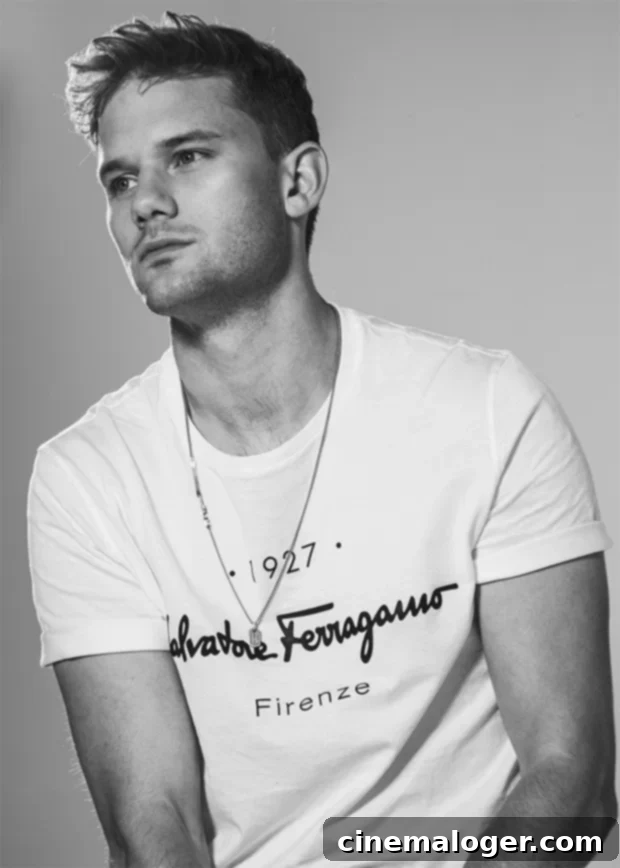Jeremy Irvine Reveals Treadstone’s Thrills: Bentley’s Cold War Espionage, Psychological Battles, and the Enduring Legacy of the Bourne Universe
The highly anticipated premiere of USA Network’s ‘Treadstone’ offered viewers a thrilling, high-stakes entry point into the iconic ‘Bourne’ universe. This spin-off series introduces a compelling array of new characters while meticulously weaving a narrative that expands upon the established lore. The series opener, which debuted on October 15th, masterfully laid the groundwork for what promises to be an action-packed and psychologically intense season.
Central to this new chapter is J. Randolph Bentley, portrayed by the talented Jeremy Irvine. Bentley is a CIA spy who finds himself in an unimaginable predicament: held captive for many months under mysterious circumstances. His dramatic escape in the premiere episode immediately raises a crucial question that will drive much of the season’s intrigue: was his escape genuine, or merely another calculated step in a far larger, more sinister plan? HollywoodLife recently had the exclusive opportunity to sit down with Jeremy Irvine, delving into his experience diving deep into the clandestine world of ‘Bourne,’ the rigorous training regimen he underwent, and what lies ahead for his enigmatic character, Bentley.
The Allure of Bentley: A Deep Dive into the Bourne World
When asked what specifically drew him to the complex role of J. Randolph Bentley and compelled him to join the expansive ‘Bourne’ universe, Jeremy Irvine’s enthusiasm was palpable. “I’ve always been a huge Jason Bourne fan,” he shared, highlighting his personal connection to the franchise. A pivotal conversation with Ben Smith, a producer renowned for his work on the original ‘Bourne’ films, solidified Irvine’s decision. “For someone like him at the helm of this—he produced the ‘Bourne’ movies as well—you kind of trust their creative judgment,” Irvine explained, emphasizing the confidence inspired by Smith’s proven expertise.
Irvine also shed light on the unique production process, where actors received scripts on an episode-by-episode basis. This approach meant that the full trajectory of his character was initially unknown. “We got one episode at a time as we filmed, so we didn’t really know where the character was going. I was just taking his word for it,” he recalled. However, what began as a leap of faith quickly evolved into a deeply collaborative journey. Irvine, primarily accustomed to film and theater, initially expected a rigid environment where lines were sacrosanct and studio control absolute. To his pleasant surprise, the reality proved quite different. “Then I started working with Ben and we’d spend hours sort of reworking scenes with the writers. It really felt like a very collaborative process,” he revealed. This unexpected creative freedom became a significant draw for him, validating his decision. “So that was a big appeal to me, especially once we’d started. I was like, ‘All right, this was a good decision.'”
Beyond the creative appeal, Irvine also underscored the significant time commitment involved in a television series of this scale. “Because it’s also a huge time commitment. You sign up to a movie and it’s like two months of your life. Sign up to something like this and there’s a whole year from starting training for it to finishing it,” he elaborated, contrasting the demands of film versus episodic television. The prolonged engagement, from initial preparation to final shoot, requires immense dedication and passion, qualities Irvine clearly brings to his role.
Intense Training: The Physical Demands of a Bourne Character
The ‘Treadstone’ premiere showcased incredibly intense stunt sequences, a hallmark of the ‘Bourne’ legacy. Irvine shared insights into the rigorous training process he underwent to prepare for these physically demanding scenes. “It was great. I started it a couple of months before we started filming,” he stated, highlighting the extensive preparation time. The show’s creators were committed to authenticity, desiring all fight choreography to appear as real and visceral as possible. “The stunts seemed clear, that they wanted all the fighting to be real,” Irvine noted.
To achieve this level of realism, Irvine received training in a diverse range of martial arts styles and specialized techniques typically taught to Special Forces operatives. “So we learned all the different sorts of martial arts styles and all the sorts of techniques that are actually taught at Special Forces and things,” he explained. The process involved mastering these skills authentically first, then adapting them for the camera. “I learned it for real first and then learned how to do it for the camera and without actually hitting someone, which is important,” he clarified, emphasizing the crucial balance between combat effectiveness and on-screen safety.
The training was undeniably physical and demanding, pushing Irvine to his limits. However, he admitted that it also tapped into a childhood fantasy. “It was very physical and demanding. But at the same time, it’s kind of every boy’s dreams. It was lovely and it was running around kicking ass, that was great,” he confessed with a grin, revealing the inherent thrill of performing such dynamic action. This dedication to practical, grounded action is a core tenet of the ‘Bourne’ universe, and Irvine’s commitment ensures that ‘Treadstone’ continues this legacy.
Bentley’s Post-Escape Journey: A Moral Labyrinth
The premiere’s climactic moment sees Bentley successfully escape his captors. This pivotal event immediately launches him into a complex and morally ambiguous journey. Irvine elaborated on the internal and external struggles Bentley faces from this point forward. “I think mostly for Bentley, and this is what I liked about the original ‘Bourne’ films, he’s trying to work out — are they good guys or are they bad guys?” Irvine posed, highlighting the existential crisis at the heart of his character’s arc. Bentley, initially believing himself to be on the side of justice, is forced to confront the disturbing possibility that his allegiances might be profoundly misplaced.
The question of whether his escape was truly his own doing, or a meticulously orchestrated part of a larger scheme, looms large. “Has he been allowed to escape? Was that all part of the plan from this sort of mind control program he’s been in? Has he been deliberately allowed to be sent back to the CIA? Is he now going to be used as a weapon against his own country?” Irvine questioned, detailing the layers of deception and manipulation Bentley must navigate. His journey becomes a desperate quest to uncover the truth, to “make things right,” despite the potentially devastating discoveries he might unearth along the way. This intricate web of conspiracy and personal identity forms the emotional backbone of Bentley’s narrative.
The Power of Psychology: Beyond the Action
When asked if Bentley’s journey is as much an internal struggle as it is an external one, Irvine emphatically affirmed, emphasizing the psychological thriller aspect as the most rewarding element of the show. “The thing that I enjoyed the most, and I’d say it’s more than the action, is the sort of psychological thriller side of it,” he stated. While acknowledging that “Every actor loves doing action scenes” and that “The reality of them is they’re great fun, but it’s a lot of time to film those big sequences,” Irvine’s true passion lies in the nuanced performances demanded by deeper, character-driven moments.
“For me, the most enjoyable thing is just to have a scene where you have to create all the excitement of the action scene, but with just you and another actor in a room having to have a conversation,” he explained. These intense, dialogue-heavy scenes, where tension and subtext drive the narrative forward, are where Irvine finds the greatest satisfaction. They allow for a profound exploration of character motivations, fears, and internal conflicts, making them “the most rewarding scenes to shoot.” This focus on psychological depth ensures that ‘Treadstone’ offers more than just spectacular stunts, delving into the minds of its protagonists.
Re-Entry: Bentley’s Return to a Paranoia-Ridden World
Bentley’s re-entry into the “normal” world, particularly the politically charged climate of 1973, presents its own unique set of challenges. Irvine elaborated on how not only Bentley struggles to adapt, but also how others perceive and react to him. “Well, it’s more about how other people handle him,” he clarified. The decision to set Bentley’s storyline during the Cold War in 1973 was a deliberate and effective choice, as it amplifies the inherent paranoia of the era. “I think the Cold War is a great time to set my storyline. Because it’s such a time of paranoia, especially amongst Americans and sort of between the East and West,” Irvine explained.
For someone returning from behind the Iron Curtain, Bentley faces immense suspicion. “For someone to come back from the other side—the Iron Curtain—he’s met with a lot of suspicions, which was a serious thing back then,” Irvine recounted. The threat of being a double agent was a palpable and severe concern during this period, leading to profound distrust. “You’re suspected of possibly being a double agent and that’s a serious thing. He’s got to sort of find a way of convincing his side that he’s still on that side,” Irvine stated, outlining the formidable task Bentley faces in proving his loyalty and reintegrating into a world that views him with skepticism.
Authentic Settings: Immersing in the Cold War Era
The tangible atmosphere of the Cold War era in 1973 was vividly brought to life through ‘Treadstone’s’ choice of filming locations. Irvine expressed his appreciation for being able to film in places that genuinely reflected the period. “It’s great being somewhere like Budapest, which was under Soviet control until 1991. So really not that long ago,” he noted. This historical proximity provided an authentic backdrop, reducing the need for extensive imagination or set dressing.
“So filming that and filming it as Soviet-controlled Budapest and East Berlin was kind of great. Because you didn’t have to do much imagining. A lot of it is still there and it still looks the way that it did back then,” Irvine explained, emphasizing the natural immersion provided by the locations. As a self-proclaimed “history nerd,” Irvine found immense satisfaction in this aspect of the production. “So it’s very easy to sort of immerse yourself in that world actually. I’m a bit of a history nerd so I love all that stuff,” he confessed. The historical authenticity of the settings not only enriched his performance but also undoubtedly enhances the viewer’s experience, transporting them directly into the tense geopolitical landscape of the Cold War.


The Enduring Appeal of the Bourne Universe: Realism Over Spectacle
The ‘Bourne’ universe continues to captivate audiences years after its initial inception. Jeremy Irvine offered his perspective on this enduring appeal, drawing a compelling contrast with other spy franchises. “Well, I can only speak for myself, but for me, I grew up in the sort of Pierce Brosnan-James Bond era,” he began, setting the stage for a comparison. “And then ‘Bourne’ came along and completely flipped that on its head.”
Irvine elaborated on how ‘Bourne’ revolutionized the spy genre by eschewing the heightened drama and fantastical elements often associated with Bond. “It completely went away from the sort of heightened drama of Bond and made it super visceral and super real and super grounded,” he explained. This commitment to realism, grittiness, and a grounded approach to action is a legacy that ‘Treadstone’ proudly carries forward. “I think we hold onto that in this. The fight sequences are kept as real as possible,” Irvine affirmed.
He further highlighted the show’s dedication to practical effects and live action over green screen wizardry. “Everything was shot live in front of the camera. We weren’t doing big fights in front of green screens and having your stunt double do most of it,” Irvine asserted. This hands-on approach means that actors are directly involved in the demanding choreography, pushing the boundaries of what’s possible on screen. The commitment to this level of authenticity comes with its own challenges, including a higher risk of on-set incidents. “We had a lot of injuries. We had a lot of times it went wrong,” he admitted, acknowledging the physical toll taken during production.
However, Irvine believes these challenges are a testament to the crew’s dedication and ultimately enhance the final product. “But I think that’s what happens when you really push the envelope of what’s possible in action,” he concluded. It’s this unwavering pursuit of raw, unvarnished realism that continues to define and distinguish the ‘Bourne’ universe, drawing viewers into its compelling narratives and breathtaking action sequences.
The Future of Bentley: A Question of Survival
The premiere episode notably featured Petra in the present day, leaving audiences to wonder about the fate of characters like Bentley. When asked about the possibility of seeing Bentley in the present day, Irvine maintained the show’s signature air of mystery. “I don’t know. We’ll have to see if he survives,” he teased, hinting at the precarious nature of his character’s existence within the ‘Treadstone’ narrative.
Irvine also humorously recalled the uncertainty that enveloped the cast during filming, as they, much like the audience, received scripts on an episode-by-episode basis. “That was the funny thing while shooting. We were getting each episode at a time. I was going, ‘I’m sure he’s got to die. I’m sure he’s got to die.’ And each episode I was waiting to see how I would die,” he shared, underscoring the constant tension and suspense inherent in the production process itself. The question of Bentley’s ultimate fate remains a tantalizing cliffhanger, compelling viewers to tune in to ‘Treadstone’ to uncover the answers as the season unfolds.
